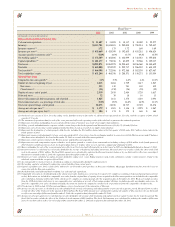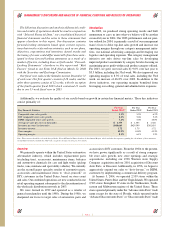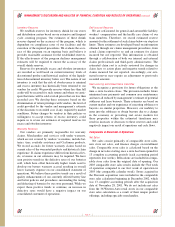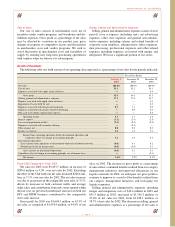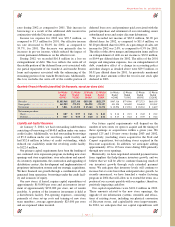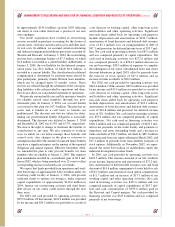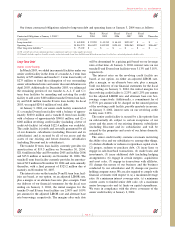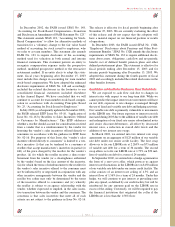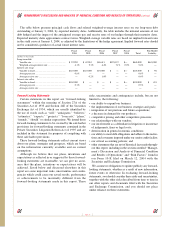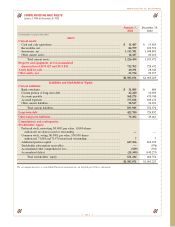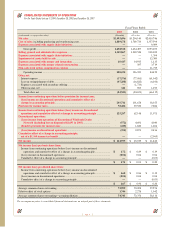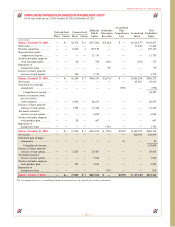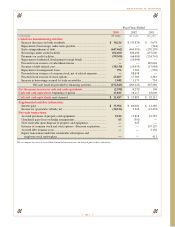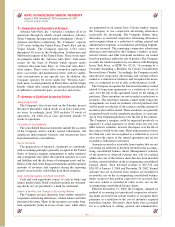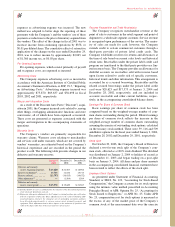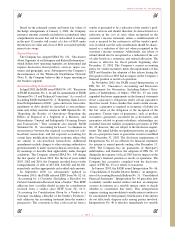Advance Auto Parts 2003 Annual Report Download - page 23
Download and view the complete annual report
Please find page 23 of the 2003 Advance Auto Parts annual report below. You can navigate through the pages in the report by either clicking on the pages listed below, or by using the keyword search tool below to find specific information within the annual report.
In December 2002, the FASB issued SFAS No. 148,
“Accounting for Stock-Based Compensation—Transition
and Disclosure an Amendment of FASB Statement No. 123.”
This statement amends SFAS 123, “Accounting for Stock-
Based Compensation” to allow for alternative methods of
transition for a voluntary change to the fair value based
method of accounting for stock issued to employees, who
we refer to as team members. This statement also amends
FASB No. 123 to require disclosure of the accounting
method used for valuation in both annual and interim
financial statements. This statement permits an entity to
recognize compensation expense under the prospective
method, modified prospective method or the retroactive
restatement method. If an entity elects to adopt this state-
ment, fiscal years beginning after December 15, 2003
must include this change in accounting for team member
stock-based compensation. We have adopted the enhanced
disclosure requirements of SFAS No. 148 and accordingly
included the related disclosures in the footnotes to our
consolidated financial statements included elsewhere
in this Annual Report. We have concluded that we will
continue to account for team member stock-based compen-
sation in accordance with Accounting Principles Board
No. 25, “Accounting for Stock Issued to Employees.”
In July 2003 (as subsequently updated in November 2003),
the FASB released EITF Issue No. 03-10, “Application of
Issue No. 02-16 by Resellers to Sales Incentives Offered
to Customers by Manufacturers.” This EITF addresses
whether a reseller should account for consideration received
from a vendor that is a reimbursement by the vendor for
honoring the vendor’s sales incentives offered directly to
consumers in accordance with the guidance in EITF Issue
No. 02-16. For purposes of this Issue, the “vendor’s sales
incentive offered directly to consumers” is limited to a ven-
dor’s incentive (i) that can be tendered by a consumer at
resellers that accept manufacturer’s incentives in partial (or
full) of the price charged by the reseller for the vendor’s
product, (ii) for which the reseller receives a direct reim-
bursement from the vendor (or a clearinghouse authorized
by the vendor) based on the face amount of the incentive,
(iii) for which the terms of reimbursement to the reseller for
the vendor’s sales incentive offered to the consumer must
not be influenced by or negotiated in conjunction with any
other incentive arrangements between the vendor and the
reseller but, rather may only be determined by the terms
of the incentive offered to consumers and (iv) whereby
the reseller is subject to an agency relationship with the
vendor, whether expressed or implied, in the sales incen-
tive transaction between the vendor and the consumer. The
consensus is that sales incentives that meet all of such
criteria are not subject to the guidance in Issue No. 02-16.
The release is effective for fiscal periods beginning after
November 25, 2003. We are currently evaluating the effect
of this release and do not expect that the adoption will
have a material impact on our financial position or results
of operations.
In December 2003, the FASB issued SFAS No. 132R,
“Employers’ Disclosures about Pensions and Other Post-
retirement Benefits.” SFAS No. 132R amends the disclosure
requirements of SFAS No. 132 to require additional disclo-
sures about assets, obligations, cash flow and net periodic
benefit cost of defined benefit pension plans and other
defined postretirement plans. This statement is effective for
fiscal periods ending after December 15, 2003 and for
interim periods beginning after December 15, 2003. We
adopted this statement during the fourth quarter of fiscal
2003 and accordingly included the related disclosures in the
other benefits footnote.
Quantitative and Qualitative Disclosures About Market Risks
We are exposed to cash flow risk due to changes in
interest rates with respect to our long-term debt. While we
cannot predict the impact interest rate movements will have
on our debt, exposure to rate changes is managed through
the use of fixed and variable rate debt and hedging activities.
Our variable rate debt is primarily vulnerable to movements
in the LIBOR rate. Our future exposure to interest rate risk
increased during 2003 due to the addition of variable rate debt
and redemption of our fixed rate senior subordinated notes
and senior discount debentures, all offset by decreased
interest rates, a reduction in overall debt levels and the
addition of two interest rate swaps.
In March 2003, we entered into two interest rate swap
agreements on an aggregate of $125 million of our variable
rate debt under our senior credit facility. The first swap
allows us to fix our LIBOR rate at 2.269% on $75 million
of variable rate debt for a term of 36 months. The second
swap allows us to fix our LIBOR rate at 1.79% on $50 mil-
lion of variable rate debt for a term of 24 months.
In September 2002, we entered into a hedge agreement in
the form of a zero-cost collar, which protects us against
interest rate fluctuations in the LIBOR rate on $150 million
of our variable rate debt under our senior credit facility. The
collar consists of an interest rate ceiling of 4.5% and an
interest floor of 1.56% for a term of 24 months. Under this
hedge, we will continue to pay interest at prevailing rates
plus any spread, as defined by our credit facility, but will be
reimbursed for any amounts paid on the LIBOR rate in
excess of the ceiling. Conversely, we will be required to pay
the financial institution that originated the collar if the
LIBOR rate is less than the 1.56% floor.
Page 21
Advance Auto Parts, Inc. and Subsidiaries


